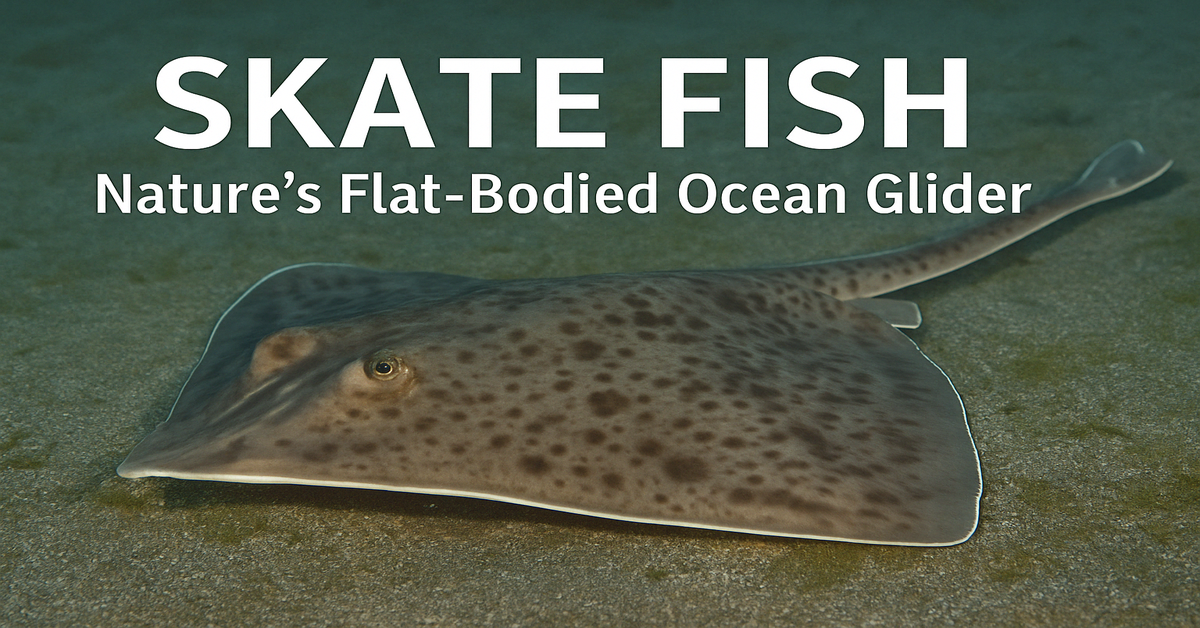In the vast expanse of the ocean, where creatures of all shapes and sizes navigate through dynamic ecosystems, the skate fish stands out as a unique and fascinating marine species. With a flattened body and wing-like fins, skates are often mistaken for stingrays, but they are a distinct group with their own biological features, ecological roles, and culinary relevance.
Skate fish belong to a class of cartilaginous fish known as elasmobranchs, which also includes sharks and rays. Their graceful movement across the ocean floor and evolutionary adaptations have intrigued marine biologists and fishermen alike for generations.
This article offers an in-depth look at the skate fish—from anatomy and habitat to its role in marine ecosystems and human consumption.
Taxonomy and Classification
Scientific Classification
Skate fish belong to the family Rajidae and fall under the order Rajiformes. They are part of the subclass Elasmobranchii, which includes all sharks, skates, and rays.
- Kingdom: Animalia
- Phylum: Chordata
- Class: Chondrichthyes (cartilaginous fishes)
- Order: Rajiformes
- Family: Rajidae
There are over 200 known species of skates worldwide, each adapted to specific oceanic conditions.
Differentiating Skates from Rays
Although similar in appearance, skates are different from rays in several key aspects:
- Skates have thicker tails without venomous barbs (unlike rays).
- Rays are typically live-bearers, while skates lay egg cases.
- Skates often inhabit colder, deeper waters compared to rays.
Physical Characteristics
Body Structure
Skate fish have a broad, flattened body that allows them to glide along the seabed. Their large pectoral fins, which extend from the head region, give them a disc-like shape.
Skin and Texture
The skin of a skate is rough and often covered in dermal denticles, small tooth-like structures that offer protection and reduce drag in the water.
Tail and Fins
Skates have a short, muscular tail that lacks the stinging barb found in rays. Instead, many species possess thorny projections or spines along the tail and back for defense.
Size and Coloration
- Size ranges from 30 cm to over 2 meters, depending on the species.
- Colors are typically muted: shades of brown, gray, or tan, often with spots or mottled patterns that provide camouflage against sandy or rocky seafloors.
Habitat and Distribution
Global Range
Skates are found in oceans across the globe, primarily in:
- Temperate and polar regions
- Continental shelves
- Deep-sea environments, especially on muddy or sandy bottoms
They are most common in the North Atlantic and North Pacific but are also found off the coasts of South America, Australia, and parts of Asia.
Preferred Environments
Skates are demersal, meaning they live and feed on or near the ocean floor. They prefer:
- Cold to temperate waters
- Depths ranging from shallow coastal zones to over 1,000 meters
- Soft substrates for burying themselves during rest
Behavior and Adaptations
Feeding Habits
Skates are carnivorous, feeding primarily on:
- Crustaceans (crabs, shrimp)
- Small fish
- Mollusks (clams, squid)
- Worms and benthic invertebrates
They use their powerful jaws to crush the hard shells of prey.
Locomotion
The skate’s movement is both graceful and efficient. They “fly” through the water by:
- Undulating their pectoral fins
- Using slight tail movements for balance and direction
Their camouflage and slow, stealthy movement help them ambush prey.
Reproduction
Skates reproduce through oviparity, meaning they lay eggs rather than giving birth to live young. Their eggs are enclosed in leathery capsules known as:
- Mermaid’s purses
These egg cases often wash ashore and can be found by beachcombers.
The development of the embryo inside can take several months, depending on the temperature and species.
Ecological Role
Predator and Prey
Skates play an essential role in the marine food chain:
- They control populations of bottom-dwelling prey
- They serve as food for larger predators like sharks, seals, and large fish
Indicator Species
Because they are sensitive to environmental changes, skates are considered indicator species. A decline in skate populations can signal:
- Overfishing
- Habitat degradation
- Pollution
Commercial Importance
Fisheries and Bycatch
Skates are often:
- Targeted directly in commercial fisheries for their meat
- Caught as bycatch in trawling operations, especially in cold waters
In some regions, skate populations have declined due to overfishing, prompting stricter regulations and conservation efforts.
Culinary Uses
In many countries, particularly in Europe and Asia, skate meat is considered a delicacy. Key culinary facts:
- Only the wings (pectoral fins) are typically eaten
- The meat is white, flaky, and mild, with a slightly sweet flavor
- It’s often described as having a texture between scallop and crab
Common dishes include:
- Skate wing with brown butter (France)
- Pan-seared skate with lemon and capers
- Korean grilled skate (hongeo-gui)
Skate cartilage, which resembles strands when cooked, is sometimes mistaken for fibrous tissue but is perfectly edible.
Sustainability and Conservation
Threats to Skate Populations
Several factors threaten skate populations:
- Overfishing, especially in trawl fisheries
- Slow reproduction rates, making them vulnerable to population crashes
- Habitat destruction, including seabed dredging and pollution
Conservation Measures
Efforts to protect skate species include:
- Fishing quotas and size limits
- Bycatch reduction technologies
- Marine protected areas (MPAs)
- Public awareness and education
Some species, such as the common skate (Dipturus batis), are listed as critically endangered due to past overexploitation.
Skates in Culture and Science
Traditional Beliefs
In some cultures, skate was historically used for medicinal or symbolic purposes, believed to:
- Stimulate appetite
- Treat skin conditions
- Represent resilience due to its armored exterior
Scientific Interest
Marine biologists study skates for insights into:
- Cartilage development
- Locomotion mechanics
- Sensory systems like electroreception (used to detect prey)
Skates, like sharks, possess ampullae of Lorenzini, which detect electrical fields in the water.
Aquariums and Public Education
Display and Observation
Several public aquariums around the world feature skates in their exhibits, allowing visitors to:
- Observe their movement
- Learn about their ecology
- Touch smaller species in interactive tanks
These exhibits promote marine conservation and inspire curiosity in marine science.
Species in Captivity
Common species in aquariums include:
- Little Skate (Leucoraja erinacea)
- Clearnose Skate
- Big Skate (Beringraja binoculata)
These species are generally hardy and can thrive in large tank environments when well cared for.
Skate vs. Other Cartilaginous Fish
| Feature | Skate | Ray | Shark |
|---|---|---|---|
| Body Shape | Flat, disc-like | Flat, disc-like | Torpedo-shaped |
| Tail | Thick, without barb | Thin, often with barb | Muscular, finned |
| Reproduction | Lays eggs | Live birth | Mostly live birth |
| Habitat | Ocean floor (demersal) | Ocean floor and open water | Wide variety of habitats |
| Culinary Value | Wings consumed | Wings (occasionally) | Meat and fins (controversial) |
Conclusion
The skate fish may not be as flashy as a shark or as famous as a stingray, but it is a vital and fascinating member of the marine world. Its understated presence on the ocean floor belies a rich biology, ecological importance, and even culinary value that spans cultures and continents.
From its intricate egg cases and efficient swimming technique to its role in fisheries and conservation discussions, the skate represents both the mystery and fragility of ocean life.
As ocean stewardship becomes ever more important in the face of climate change and overfishing, understanding creatures like the skate can inspire more mindful practices and a deeper appreciation of our underwater ecosystems.
FAQs
1. Are skate fish the same as stingrays?
No. While they look similar, skates and stingrays are different species. Skates lay eggs and lack venomous tails, while stingrays give live birth and may have stingers.
2. Is it safe to eat skate?
Yes, skate is edible and considered a delicacy in many countries. The wings are the most commonly consumed part, known for their delicate, sweet flavor.
3. Can skate fish sting you?
No. Unlike stingrays, skates do not have venomous barbs on their tails and are generally harmless to humans.
4. Where can skate fish be found?
Skates inhabit ocean floors around the world, especially in cold to temperate waters. They are commonly found on continental shelves and in deep-sea environments.
5. How do skates reproduce?
Skates reproduce by laying egg cases, often called “mermaid’s purses.” The embryos develop inside and hatch after several months.
6. Are skate populations endangered?
Some species of skate are considered endangered or vulnerable due to overfishing and habitat destruction. Conservation efforts are in place to protect them.











